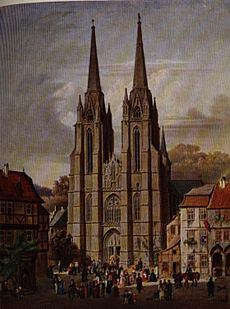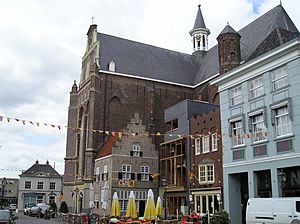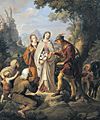Elizabeth of Hungary facts for kids
Quick facts for kids SaintElizabeth of Hungary T.O.S.F. |
|
|---|---|
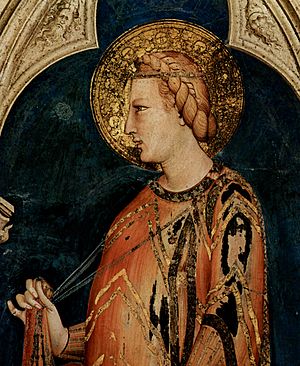
Elizabeth of Hungary by Simone Martini
|
|
| Widow and Landgravine | |
| Born | 7 July 1207 Pozsony, Kingdom of Hungary (modern-day Bratislava, Slovakia) |
| Died | 17 November 1231 (aged 24) Marburg, Landgraviate of Thuringia, Holy Roman Empire (modern-day Hesse, Germany) |
| Venerated in | Catholic Church Anglican Communion Lutheranism |
| Canonized | 27 May 1235, Perugia, Italy by Pope Gregory IX |
| Major shrine | St Elisabeth Cathedral, Košice, Slovakia St. Elizabeth Church, Marburg, Germany |
| Feast | 17 November 19 November (General Roman Calendar of 1960) |
| Attributes | Roses, crown, food basket |
| Patronage | hospitals; nurses; falsely accused people; bakers; brides; countesses; dying children; exiles; homeless people; lace-makers; widows; Bogotá, Colombia; Roman Catholic Archdiocese of Bogotá; Roman Catholic Archdiocese of Jaro; Teutonic Order; Third Order of Saint Francis; Budapest, Hungary and Košice, Slovakia |
Elizabeth of Hungary (born July 7, 1207 – died November 17, 1231) was a princess from the Kingdom of Hungary. She became a "landgravine" (a type of noble ruler) in Thuringia, Germany. She is also known as Saint Elizabeth of Thuringia.
Elizabeth married at age 14 and became a widow at 20. After her husband died, she used her "dowry" (money or property a wife brings to a marriage) to build a hospital. She even worked there herself, helping the sick. Elizabeth became a symbol of Christian kindness after her death at just 24 years old. She was made a saint in 1235 by the Catholic Church. She was an early member of the Third Order of St. Francis, a group of people who follow the teachings of Francis of Assisi. Today, she is honored as their special protector or "patroness."
Contents
Early Life and Marriage
Elizabeth was the daughter of King Andrew II of Hungary. Her mother was Gertrude of Merania. Elizabeth's family was connected to many important royal families in Europe.
Some stories say she was born in Hungary, perhaps at Sárospatak Castle, on July 7, 1207. Other stories say she was born in Pozsony, Hungary (now Bratislava, Slovakia). She lived in the Castle of Posonium until she was four.
When she was four, Elizabeth was sent to the court of Thuringia in central Germany. This was so she could be "betrothed" (promised in marriage) to Louis IV, Landgrave of Thuringia. This marriage would help strengthen political ties between their families. Elizabeth grew up at the Thuringian court. She learned the local language and culture.
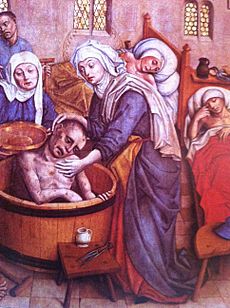
In 1221, at age 14, Elizabeth married Louis. He became the landgrave that same year. Their marriage seemed to be a happy one.
Religious Beliefs and Influences
In 1223, Franciscan friars arrived in Thuringia. Elizabeth, still a teenager, learned about the ideas of Francis of Assisi. She began to live by these ideas herself. Louis supported his wife's charitable work. He believed that giving his wealth to the poor would bring good rewards in the afterlife. He is seen as a saint in Thuringia, even though the church never officially made him one.
Around this time, a priest named Konrad von Marburg became very important in Elizabeth's life. He was appointed as her "confessor," a priest who listens to people's confessions and gives spiritual advice. Konrad had a strong influence on Elizabeth.
In the spring of 1226, Thuringia suffered from floods, famine, and sickness. Louis was away, representing the Holy Roman Emperor. Elizabeth took charge at home. She gave away food and help to the poor all over their land. She even gave away her own royal robes and jewelry to those in need.
Widowhood and New Life
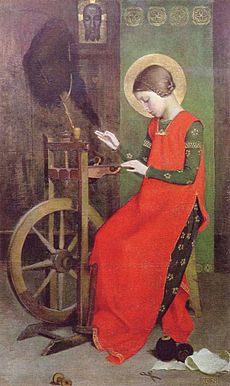
Elizabeth's life changed greatly on September 11, 1227. Her husband Louis died from a fever in Otranto, Italy. He was on his way to join a religious war called the Sixth Crusade. This happened just weeks before their daughter Gertrude was born. When Elizabeth heard the news, she reportedly said, "He is dead. It is to me as if the whole world died today." Louis's body was brought back in 1228 and buried.
After Louis's death, his brother, Henry Raspe, took over as ruler while Elizabeth's son, Hermann, was still a child. There were disagreements about Elizabeth's "dowry" money. The Pope appointed Konrad von Marburg to help Elizabeth with her case. Elizabeth then left the court at Wartburg and moved to Marburg in Hesse.
For a long time, people thought Elizabeth was forced out of Wartburg by her brother-in-law. However, later research suggests she left willingly. She wanted to follow Konrad's strict rules about how she should live.
After her husband's death, Elizabeth made special promises to Konrad. These were similar to the promises a nun makes. She promised to remain unmarried and to obey Konrad as her spiritual guide. Konrad was very strict with Elizabeth. He held her to very high standards. Some stories say he even ordered her to be physically punished. He also told her to send away her three children.
Elizabeth's family wanted her to remarry for political reasons. She was even held at Pottenstein Castle by her uncle to try and make her change her mind. But Elizabeth kept her promise. She even threatened to cut off her own nose so no man would want to marry her.
Elizabeth's second child, Sophie, later married and became an ancestor of many rulers. Elizabeth's third child, Gertrude of Altenberg, was born after her father died. Gertrude later became the head of a monastery.
Elizabeth used the money from her dowry to build a hospital in Marburg. There, she and her friends cared for the poor and sick.
Amazing Stories and Miracles
The Miracle of the Roses
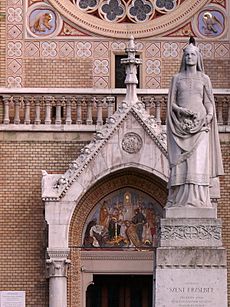
Elizabeth is famous for the "miracle of the roses." One day, she was secretly taking bread to the poor. She met her husband Louis, who was on a hunting trip. People at court suspected she was taking treasure from the castle. To clear her name, Louis asked her to show what was under her cloak. At that moment, her cloak opened, and instead of bread, there were beautiful white and red roses. This showed Louis that God was protecting her.
According to stories, her husband always supported her charity and was never bothered by it. In some versions of this story, her brother-in-law, Heinrich Raspe, is the one who questions her. This story is one of many that connect Christian saints with roses.
Christ in the Bed
Another story about Elizabeth tells how she put a sick man with leprosy in the bed she shared with her husband. Her mother-in-law was horrified and immediately told Louis when he returned. When Louis angrily pulled back the covers, the story says "God opened the eyes of his soul." Instead of the sick man, Louis saw the image of Jesus Christ on the cross lying in the bed.
Death and Lasting Impact
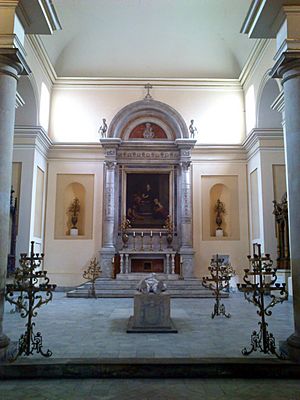
Elizabeth died in Marburg in 1231, when she was only 24 years old.
Miracles After Death and Becoming a Saint
Soon after Elizabeth died, people reported miracles happening at her grave. Many people said they were healed there. Because of this, the Pope ordered an investigation. People who had been healed were interviewed. Their stories, along with accounts from Elizabeth's close friends, were enough proof. She was made a saint by Pope Gregory IX on May 24, 1235.
The official document declaring her a saint can be seen in Vienna, Austria. Her body was placed in a beautiful golden shrine. This shrine is still in the Elisabethkirche in Marburg, Germany. Marburg became an important center for the Teutonic Order, a group of knights. They chose Saint Elizabeth as one of their main protectors. The Elisabethkirche is now a Protestant church, but it still has areas for Catholic worship.
Elizabeth's shrine became a major place for "pilgrimages" (religious journeys) in Germany during the 1300s and early 1400s. Over time, her popularity as a saint slowly faded. However, many noble German families still honored her because she was an ancestor to them through her daughter Sophia.
Three hundred years after her death, one of Elizabeth's descendants, Philip I, Landgrave of Hesse, was a leader of the Protestant Reformation. He raided the church in Marburg. He wanted to take Elizabeth's bones to stop the pilgrimages. Philip took a special cup where her head rested, but he later returned it.
Some of Elizabeth's bones and her skull are now in a convent in Vienna. Other parts of her relics (holy remains) are in different churches around the world, including in Brussels, Hanover, and Bogotá, Colombia.
Elizabeth of Hungary is remembered in the Church of England on November 18 and in the Episcopal Church on November 19.
Connection with the Franciscans
After her death, Elizabeth was often linked to the Third Order of Saint Francis. This group is mostly made up of everyday people who follow Franciscan teachings. They helped spread her story. It's not fully proven if she officially joined the order, as it was very new when she married at 14.
However, Elizabeth clearly had a special ceremony where she adopted a Franciscan way of life. She supported the friars who came to Thuringia. Because of this, she became known to Francis of Assisi himself. He sent her a personal blessing before he died in 1226. When she was made a saint, she was declared the "patron saint" (special protector) of the Third Order of St. Francis. She shares this honor with Louis IX of France.
In Art and Music
Saint Elizabeth is often shown in art holding a basket of bread or other food. This shows her dedication to helping the poor and hungry. The "miracle of the roses" is also a popular subject for artists.
2007 Celebrations
The year 2007 was called Elizabeth Year in Marburg. Events were held all year to remember Elizabeth's life and good deeds. These celebrations ended with a big town festival on July 7, 2007, to mark 800 years since her birth. People came from all over the world for the event.
A new musical about Elizabeth's life, Elisabeth--die Legende einer Heiligen (Elizabeth--Legend of a Saint), opened in Eisenach in 2007. It was performed for two years in Eisenach and Marburg.
The entire Third Order of St. Francis, including friars, sisters, and lay members, celebrated this anniversary. They spent two years studying her life. Religious ceremonies were held worldwide. The year-long celebration ended in Budapest in 2008.
Honors
To honor Saint Elizabeth of Hungary, Hungary issued special stamps on the 700th anniversary of her death in 1932. Czechoslovakia also issued a stamp in 1938 showing the Cathedral of St. Elizabeth in Košice. In 2019, she was declared the patron saint of Košice.
A hymn called "Wenn das Brot, das wir teilen" was written for a pilgrimage to places connected to her life. It mentions her Miracle of the Roses and her other acts of kindness.
Images for kids
-
From Sint Elisabethskerk, Grave, Netherlands
-
From Sint Elisabethskerk, Grave, Netherlands
-
Statue of Saint Elizabeth in St Francis Xavier Catholic Church, Superior, Wisconsin
-
A wooden sculpture of St. Elizabeth. She has on a 15th-century style dress and wears a cloak which falls to mid shin. She holds a pitcher in her left hand and at her right foot a small depiction of a man kneels and gazes up at her. By Tilman Riemenschneider, about 1492, Bayerisches Nationalmuseum, Munich
-
From Sint Elisabethskerk, Grave, Netherlands
-
From Sint Elisabethskerk, Grave, Netherlands
-
The Elizabeth Bower, Wartburg
-
Engraved print of St Elizabeth, Birmingham Museum of Art
-
The Reliquary of St. Elizabeth, taken as war booty by the Swedish army during the Thirty Years' War and currently in the Swedish History Museum, Stockholm
See also
 In Spanish: Isabel de Hungría para niños
In Spanish: Isabel de Hungría para niños
- Hungarian nobility
- Isten, hazánkért térdelünk
- Saint Elizabeth of Hungary, patron saint archive


